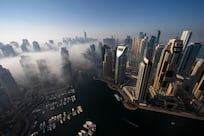When the Bollywood legend Amitabh Bachchan embraced the South Indian movie icon Mammootty moments before the Dubai International Film Festival's opening-night ceremony earlier this month, one industry insider exclaimed: "That is Indian cinema. There are no more gaps between Bollywood and the rest." A poignant moment for Indian cinema, perhaps, but Bollywood and the regional industries could not be more different in their identity and influence. In the past decade, Bachchan and his colleagues from Mumbai have helped Bollywood extend its appeal beyond the Indian diaspora. They have enthralled international audiences with their brand of cinema featuring brightly coloured and neatly choreographed song and dance routines incorporated into a melodramatic script emphasising family values. However, regional actors such as Mammootty, who goes by one name, have often expressed diplomatic disdain over the perception that Bollywood equals Indian cinema.
Although Bollywood - a term coined by the international media in the past decade much to the chagrin of its heavyweights - has been inclusive of regional talent within its Hindi-language format, its cinema represents a tiny portion of the films produced in India. The country's film industry - comprising Bollywood and 11 regional languages - has the highest production output in the world. However, films in Hindi account for only 22 per cent of the total production and contribute 25 per cent of the revenue of the Indian film industry. Bollywood's brightest stars are better known among non-Indian followers of Indian cinema, but the southern celebrities are equally capable of causing a stampede - as was the case when Mammootty, who is from Kerala, visited the UAE in October.
"India is a big enough country with large groups of audiences that are loyal to different kinds of cinema. There is no definition for Indian cinema, but to represent one kind of film as Indian is not correct," said Mammootty on the sidelines of the festival. Much of the Bollywood-versus-regional debate emanates from linguistic pride, which defines regional political movements and resistance to Hindi as the official language in India. While India's national film awards take into account the diversity of Indian cinema and send non-Hindi films as India's official entry to the Oscars, regional films are not helped by the presence of privately organised Bollywood award shows that travel around the world and market themselves as "Indian".
"When you look at something like the IIFA (International Indian Film Academy) Awards, which go to a different foreign destination every year but do not include non-Hindi films in their nominations, it is very misleading to a foreign audience that's not familiar with the entire scope of Indian cinema," says Mammootty. Interestingly, the brand ambassador for the IIFA event, which was instituted in 2000, is Bachchan, one of the most vociferous opponents of the term "Bollywood". The 67-year-old star, whose career spans more than 40 years and 150 films, has witnessed first-hand the shift in international attitudes towards the industry he works in - from ignorance to ridicule and now acceptance.
"Globally, I think our cinema has entered a stage of appreciation," said Bachchan at the Dubai festival. "We are conscious of this," he added when asked about the absence of regional cinema specifically within the IIFA context. "We've decorated people from South India, premiered their films and are consciously looking into all aspects of cinema in India to make sure they all have a presence." Changes in Indian society, brought about by globalisation, have resulted in a massive inner-Indian migration exposing communities from one part of India to previously unfamiliar forms and genres of cinema from other territories. Such opportunities were previously limited to the national broadcaster screening a regional film with English subtitles every Sunday afternoon.
"Better subtitling, marketing and distribution has definitely played a role in Bollywood cinema gaining a larger audience," says Uma Da Cunha, the editor and publisher of Film India Worldwide, a publication that covers commercial and art-house films. "The cinema divide in the 1970s and 1980s was between commercial and art only because Bollywood was essentially looked down upon. The divide is now between Bollywood and regional cinema. Regional DVDs are slowly picking up with the subtitling, but still suffer from poorer distribution and sell through video CDs. Until they reach the same professional marketing levels as Bollywood, they will face challenges in expanding their base."
Regional Indian cinema can be equally commercial, featuring the same elements - song, dance, action and emotion - that define the Bollywood genre. "The perception that Bollywood is all that Indian cinema has to offer is dangerous as it prevents regional cinema from widening its audience base," says Da Cunha, who has been associated with the Indian film industry since the 1960s and programmed art-house cinema for museums abroad.
The experience, for example, of watching a South Indian commercial film on its day of release, is a novelty in itself. "I remember watching the first show of a Tamil film, Sivaji the Boss, with Rajnikanth, a Tamil actor who's supposed to be bigger than Bachchan in terms of iconic status. The audience was a mix of all income groups of Tamilians in the UAE and the front rows went wild before the film even started, when the curtains opened. The atmosphere was like a rock concert and every time Rajnikanth came on screen, people would jump out of their seats to whistle and clap. I've never seen that kind of passion for a Bollywood film," says Laurent Caranobe, a native of France who is married to an Indian and living in the UAE.
For film curators and programming consultants such as Dorothee Wenner, who works with the Berlinale and Dubai's film festival, India is a planet in itself in terms of its cinema. "Southern cinema - if one may generalise - is even more extreme on an emotional level. It usually has a more traditional value system from which the stories are derived. Bengali and Marathi cinema draw a lot from a very rich literature, and the Malayalam movies often have explicit social messages. Yet, today, one will find proof that these patterns and distinctions are dissolving or merging, since a new generation of filmmakers is entering the scene, many of who might work in Chennai and in Mumbai. Then there are lots of intra-Indian 'remakes' happening in both directions," says Wenner.
The South Indian industries, in particular, have also always enjoyed enormous economic strength and produced a high calibre of technicians - two of whom (Resul Pookutty and AR Rahman) won Oscars for their work on Danny Boyle's Slumdog Millionaire. Since the 1960s, South Indian production houses have financed a number of Bollywood blockbusters. Mumbai's Hindi films have also welcomed actresses from other Indian states. Audience tastes in India's north, however, have proved to be a stumbling block for southern actors, as their Hindi diction and darker skin find them few fans outside their home turfs.
With adequate financial support and a large viewership, there appears to be little need to increase the fan base, as the regional stars are already iconic within their industries. There are, however, advantages in taking the regional Indian films international. "There's definitely no need. But I'm a believer in cinematographic diversity, so I also think of audiences residing beyond the Indian communities who are missing out a lot by not seeing these films," says Wenner, who uses film festivals as a springboard to introduce regional Indian films to serious fans of cinema. At the Dubai festival, Wenner facilitated the presentation of films in the Tamil, Malayalam, Bengali and Marathi languages. Although the audiences were largely from the regional communities, as was evident from the Q&A sessions, Wenner says each non-Hindi film had at least "a few non-Indians and Indians unfamiliar with the language".
Global cinema now accustomed to Bollywood might soon be hungry for material from the newer markets within India's cinema industry. Regional cinema to some extent has not completely adopted the image favoured by big-budget Bollywood films that are designed to appeal to the international and globalised Indian. As an art form, they are still widely considered a more authentic representation of the regions they originate from with scope for experimental scripts and narratives.
Sensing this untapped potential for India's regional cinema to become the next big thing, corporate entities such as Reliance Big Pictures and Moser Baer Entertainment have ventured into producing, marketing and distributing regional cinema. "It's not a strategy to position Bollywood as representative of cinema from India, but Bollywood is the closest thing India has to a national cinema. Regional cinema is collectively more prolific, but it hasn't yet grabbed the attention of foreign audiences," says Sanjeev Lamba, the chief executive of Reliance Big Pictures. The company is the media and entertainment arm of the Reliance ADA conglomerate, which made headlines through its deal with Steven Spielberg's DreamWorks.
Although the marketing and distribution machinery appears to be following the Bollywood formula, regional cinema is bound to face enormous challenges in going global. G Dhananjayan, the chief executive of Moser Baer Entertainment's film business division, understands the challenges. "South Indians account at best for about 35 per cent of the total Indians abroad. This demographic itself includes four languages and their speakers are scattered in different countries. At this point film festivals are the best route for foreign audiences to watch regional Indian films. There is definitely an opportunity, but it's still a long way from reaching Bollywood levels of popularity internationally."




